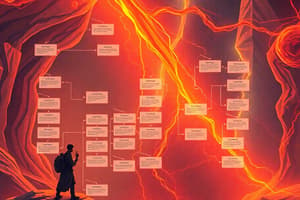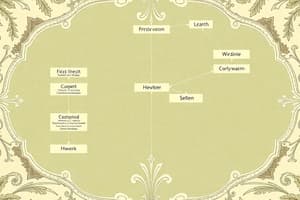Podcast
Questions and Answers
In a class diagram, what is the purpose of the top compartment of a class rectangle?
In a class diagram, what is the purpose of the top compartment of a class rectangle?
- To represent operations of the class
- To represent the name of the class (correct)
- To represent relationships with other classes
- To represent attributes of the class
What is the purpose of a use case diagram?
What is the purpose of a use case diagram?
- To describe the structure of a system
- To describe the functional requirements of a system (correct)
- To describe the behavior of an object over time
- To describe the sequence of events in a system
In a sequence diagram, what do lifelines represent?
In a sequence diagram, what do lifelines represent?
- Objects and their interactions (correct)
- The sequence of events in a system
- The flow of control in a system
- The relationships between objects
What is the purpose of an activity diagram?
What is the purpose of an activity diagram?
In a state machine diagram, what is represented by a black circle?
In a state machine diagram, what is represented by a black circle?
Which type of UML diagram is used to describe the structure of a system?
Which type of UML diagram is used to describe the structure of a system?
What is the purpose of swimlanes in an activity diagram?
What is the purpose of swimlanes in an activity diagram?
In a class diagram, what is the symbol for composition?
In a class diagram, what is the symbol for composition?
Flashcards are hidden until you start studying
Study Notes
UML Diagrams
Class Diagrams
- Used to describe the structure of a system
- Displays classes and their relationships
- Classes are represented as rectangles with three compartments:
- Top: Class name
- Middle: Attributes (data)
- Bottom: Operations (methods)
- Relationships between classes:
- Inheritance (generalization): arrow with open arrowhead
- Composition (containment): filled diamond
- Association: line with arrowhead
Use Case Diagrams
- Used to describe the functional requirements of a system
- Displays actors, use cases, and their relationships
- Actors are represented as stick figures
- Use cases are represented as ovals
- Relationships between actors and use cases:
- Communication: line between actor and use case
- System boundary: rectangle surrounding use cases
Sequence Diagrams
- Used to describe the sequence of events in a system
- Displays objects, lifelines, and messages
- Lifelines are represented as vertical dashed lines
- Objects are represented as rectangles at the top of the lifeline
- Messages are represented as arrows between lifelines
- Time increases from top to bottom
Activity Diagrams
- Used to describe the flow of control in a system
- Displays actions, decisions, and control flow
- Actions are represented as rectangles
- Decisions are represented as diamonds
- Control flow is represented as arrows between actions and decisions
- Swimlanes: vertical or horizontal partitions dividing the diagram
State Machine Diagrams
- Used to describe the behavior of an object over time
- Displays states, transitions, and events
- States are represented as rectangles
- Transitions are represented as arrows between states
- Events are represented as labels on transitions
- Initial state: black circle
- Final state: circle with a concentric circle
UML Diagrams
- Types of UML diagrams: Class, Use Case, Sequence, Activity, and State Machine diagrams
Class Diagrams
- Describe the structure of a system
- Display classes and their relationships
- Class representation:
- Rectangle with three compartments
- Top: Class name
- Middle: Attributes (data)
- Bottom: Operations (methods)
- Relationships between classes:
- Inheritance (generalization): arrow with open arrowhead
- Composition (containment): filled diamond
- Association: line with arrowhead
Use Case Diagrams
- Describe the functional requirements of a system
- Display actors, use cases, and their relationships
- Actor representation: stick figures
- Use case representation: ovals
- Relationships between actors and use cases:
- Communication: line between actor and use case
- System boundary: rectangle surrounding use cases
Sequence Diagrams
- Describe the sequence of events in a system
- Display objects, lifelines, and messages
- Lifeline representation: vertical dashed lines
- Object representation: rectangles at the top of the lifeline
- Message representation: arrows between lifelines
- Time increases from top to bottom
Activity Diagrams
- Describe the flow of control in a system
- Display actions, decisions, and control flow
- Action representation: rectangles
- Decision representation: diamonds
- Control flow representation: arrows between actions and decisions
- Swimlanes: vertical or horizontal partitions dividing the diagram
State Machine Diagrams
- Describe the behavior of an object over time
- Display states, transitions, and events
- State representation: rectangles
- Transition representation: arrows between states
- Event representation: labels on transitions
- Initial state: black circle
- Final state: circle with a concentric circle
Studying That Suits You
Use AI to generate personalized quizzes and flashcards to suit your learning preferences.




